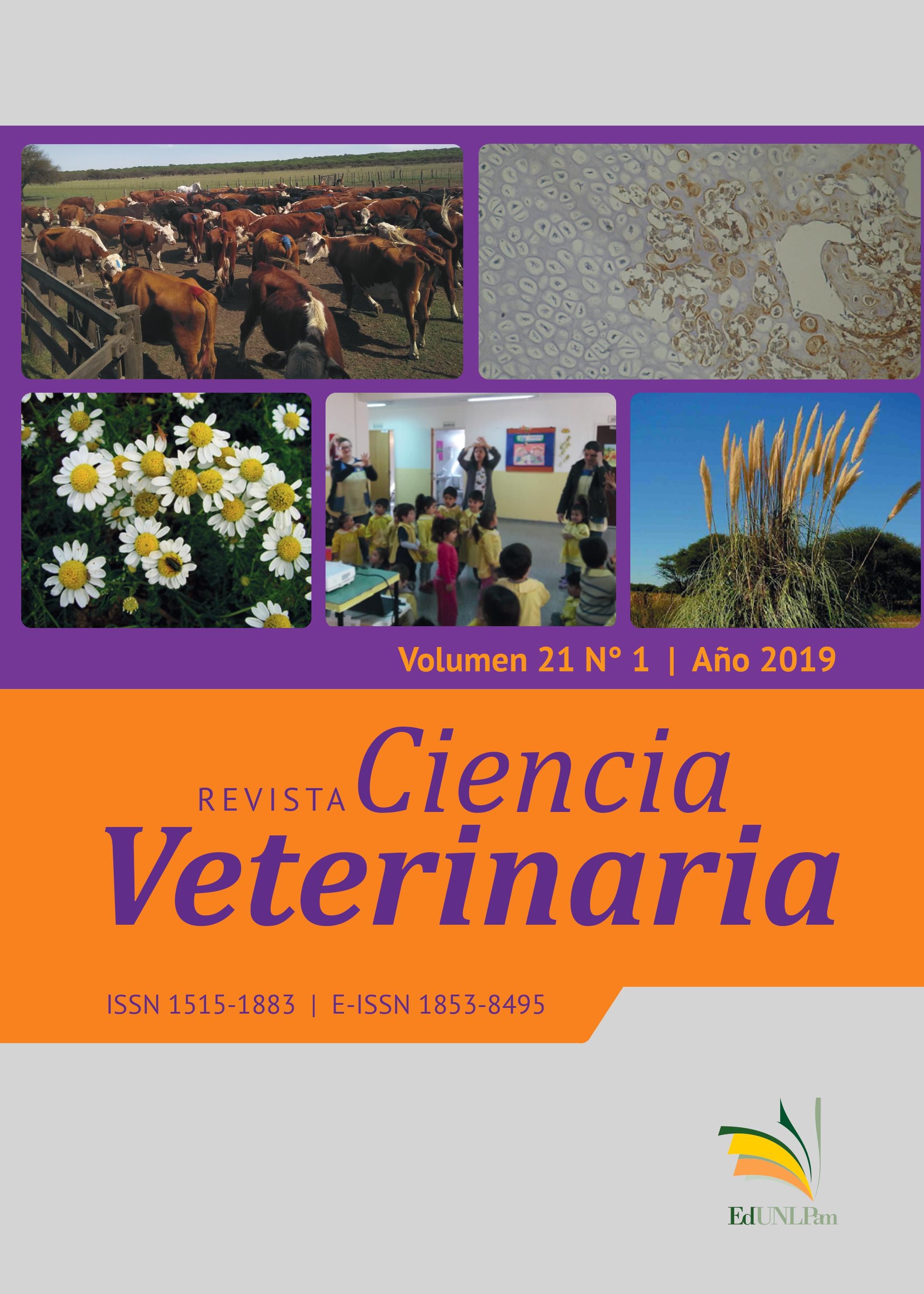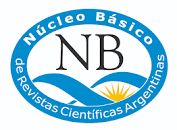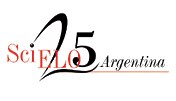Gastroprotective effect of Equisetum giganteum L. n.v. cola de caballo and Cortaderia selloana (Schult & Schultz. f.) n.v. cortadera in mice submitted to stress and indomethacin
DOI:
https://doi.org/10.19137/cienvet-201921103Keywords:
Equisetum giganteum, Cortaderia selloana, gastroprotective, indometacinAbstract
Previous studies have determined that hydro-alcoholic extracts of Equisetum giganteum (EE) and Cortaderia selloana (ECo) prevent gastric harm induced by stress in Mus musculus mice expose to hypothermia and immobilization. The aim of this study was to determine if the protective effect of indomethacin (ID), a non-steroid anti-inflammatory drug, on the gastric mucosa, is mediated by prostaglandin. The animals were assigned into one of the six groups of five animals each. The Blank Group (BG) received an oral dose (OD) of an excipient
(Ex) composed of hydroxyl methyl cellulose and tweed 80; the Control Group (CG) received excipient plus 5 mg/kg subcutaneously of ID; the Equisetum Group (EG) with EE; the Equisetum Indomethacin Group (EIG) with EE and ID; the Cortaderia Group (CoG) with Eco and the Cortaderia Indomethacin Group (CoIG) with Co and ID. The doses utilized in the animals were obtained from 1 gram of dried aerial plant parts extracted with ethanol-water (1:1; v/v) and re-suspended with Ex until 0.5 ml. The ID groups (CG, EIG, CoIG) received the doses 1 hour before the beginning of the trial, and thereafter all the groups were subjected to stress during 4 hours at 22 °C. In order to assess the gastric harm, the percentage of ulcer inhibition was calculated as follow [(AUControl or Blank Groups – AUTreated Group/AUControl or Blank Group) x 100] where AU is the Ulcerated Area . The administration of ID induced a higher degree of gastric damage in the CG than in the BG (p≤0.01). The EE administration prevented the gastric damage in four mice of the EG, but the administration of ECo prevented the damage in all the animals of the CoG (p≤0.01), demonstrating no gastroprotective effect of EE when was given concomitantly with ID. The ECo showed significant gastroprotective effects when was administered simultaneously with ID (p≤0.01) suggesting that prostaglandin would have no effect in the protection of the gastric mucosa. The findings of vegetable drugs with the observed actions are of interest in order to both replace drugs with an antagonist of H2 and inhibitors of protons pump actions, because of its side effects when are prescribed during an extended period of time.
Downloads
References
Takeuchi, K.; Ogawa, Y.; Kagawa, S.; Ukawa, H. Gastric ulcerogenic responses following barrier disruption in knockout mice lacking prostaglandin EP1 receptors.
Aliment Pharmacol Ther. 2002; 2 : 74-82.
Mönki, J.; Hewetson, M.; Virtala, A. M. Risk Factors for Equine Gastric Glandular Disease: A Case-Control Study in a Finnish Referral Hospital Population. J Vet Intern Med. 2016; 30 : 1270-5.
Dowling, P. Interacciones de los corticosteroides y los antiinflamatorios no esteroideos. Revista Veterinaria Argentina. 2011; 34 : 354. Fuente: vetpraxis.net.
Simpson, K. W. Diseases of the stomach. En: Ettinger SJ, Feldman EC, Eds. Textbook of veterinary internal medicine: diseases of the dog and cat. Séptima Edición. St. Louis, Mo: Saunders Elsevier 2010. pp. 1504-1526.
Iarushkina, N. I.; Bagaeva, T. R.; Filaretova, L. P. Somatic pain sensitivity under indometacin induced gastric and small intestinal injury in rats]. Ross Fiziol Zh Im I M Sechenova.2014; 100 : 73-85
Freeman, D. E. Gastrointestinal pharmacology. Vet Clin North Am Equine Pract. 1999; 15 : 535 - 59.
Lee, Y. H.; Mollison, K.W.; Cheng, W. D. The effects of anti-ulcer agents on indomethacin- induced gastric ulceration in the rat. Arch Int Pharmacodyn Ther.1971; 7: 191:370.
Jalilzadeh-Amin, G.; Najarnezhad, V.; Anassori, E.; Mostafavi, M.; Keshipour, H. Antiulcer properties of Glycyrrhiza glabra L. extract on experimental models of gastric ulcer in mice. Iran J Pharm Res. 2015; 14:1163-70.
Toso, F.; Alvarez, H. L.; Marron, Y. M.; Toso, R. E. Efecto gastroprotector de Equisetum giganteum L. (cola de caballo) y Cortaderia selloana (schult). (cortadera) en ratones. Revista Ciencia Veterinaria.2016; 18: 29 - 38.
Toso, R.; Steibel, P. E.; Troiani, H. O.; Oriani, D. S.; Ardoino, S.; Toribio, M.; Boeris, M. Búsqueda sistematizada de plantas con actividad farmacológica utilizando el Banco de Extractos Vegetales de Plantas Nativas y Naturalizadas de La Provincia de La Pampa. Ciencia Veterinaria. 2006; 8: 25 – 30.
Yesilada, E.; Sezik, E.; Fujita, T.; Tanaka, S.; Tabata, M. Screening of some Turkish medicinal plants for their antiulcerogenic activities. Phytotherapy Research. 1993; 7:263-265.
Toso, R. E.; Skliar, M.I. Efecto de la indometacina sobre la citoprotección de extractos de Centaurea solstitialis contra ulceras gástricas inducidas por estrés en ratones. Ciencia Veterinaria. 2000; 2: 16-20.
Takeuchi, K.; Suzuki, K.; Araki, H.; Mizoguchi, H.; Sugamoto, S.; Umdeda. Roles of endogenous prostaglandins and nitric oxide in gastroduodenal ulcerogenic responses induced in rats by hypothermic stress. J Physiol. 1999; 93: 423 - 431.
Jacobson, E. D. Circulatory mechanisms of gastric mucosal damage and protection. Gastroenterology. 1992; 102: 1788 - 1800.
Zhu, M.; Lew, T. H.; Luk, C. T. Gastric protective effect of Lentinus edodes against ethanol- induced ulceration. Fitoterapia. 1997; 68: 537 - 442.
Murakami, M.; Lam, S. K.; Inada, M. Pathophysiology and pathogenesis of acute gastric mucosal lesions after hypotermic restraint stress in rats. Gastroenterology. 1985; 88: 660 - 665.
Brzozowski, T.; Konturek, P. C.; Konturek, S. J.; Brzozowska, I.; Pawlik, T. Role of prostaglandins in gastroprotection and gastric adaptation. J PhysiolPharmacol. 2005; 5:33-55.
Downloads
Published
How to Cite
Issue
Section
License
Al momento de enviar sus contribuciones, los colaboradores deberán declarar , de manera fehaciente, que poseen el permiso del archivo o repositorio donde se obtuvieron los documentos que se anexan al trabajo, cualquiera sea su formato (manuscritos inéditos, imágenes, archivos audiovisuales, etc.), permiso que los autoriza a publicarlos y reproducirlos, liberando a la revista y sus editores de toda responsabilidad o reclamo de terceros , los autores deben adherir a la licencia Creative Commons denominada “Atribución - No Comercial CC BY-NC-SA”, mediante la cual el autor permite copiar, reproducir, distribuir, comunicar públicamente la obra y generar obras derivadas, siempre y cuando se cite y reconozca al autor original. No se permite, sin embargo, utilizar la obra con fines comerciales.







4.png)


7.png)



